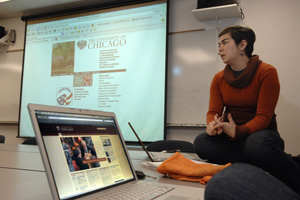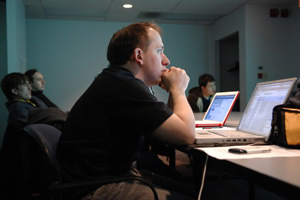As NSIT readies beta site, redesign project gets round of positive feedback
By Laurie DavisNews Office
|
|
The University’s Web redesign project, which began about three years ago, is entering its fourth and final phase of usability testing. The first three phases included nearly 1,000 responses to an online survey, 75 interviews with faculty, students, staff and alumni, an assessment of the needs of a dozen potential Web users based on user profiles, and countless ideas, designs, revisions and tweaks.
Changes will continue during the beta test phase, which will begin Monday, Feb. 18. The University community will have the opportunity to provide feedback through an online form on the beta site homepage.
“One of the primary motivations for developing a new Web site,” said Ingrid Gould, Associate Provost for Faculty and Student Affairs and member of the homepage committee, “was our belief that the old site succeeded for people who already knew the University and its structure but did not serve newcomers or visitors as effectively as we wanted. NSIT worked closely with people all over campus and off campus to reorganize information and create new sections so that folks who wanted something could locate it easily.”
Ryan Nagdeman, Director of Web and Multimedia Communications for Development and Alumni Relations, has been a member of the homepage committee since 2006 and advised during much of the project’s first phase. “I was originally interviewed by imi (information methodologies inc.), the consultant who did the requirements-gathering phase for the project. My responses and suggestions, along with other parties across campus, provided insights into the needs of the Web site’s audience,” said Nagdeman.
Christine Singer, Associate Vice President of University Alumni Relations, who also was interviewed by imi, noted the timeliness of the homepage project. “We were in the process of totally redesigning the alumni Web site, for what we’re calling the alumni Web community. It will offer alumni all kinds of wonderful ways of connecting with one another. So, I was very happy to hear that on a parallel process they were redesigning the University Web site.”
Singer said what makes the new design more inviting is the inclusion of people and their stories. “We shouldn’t be speaking to ourselves through the University Web site. We should present who we are, the best of who we are, and this includes more people. The new Web site acknowledges a world out there beyond the University campus, and tells interesting stories about students, faculty and alumni in other parts of the world.”
Nagdeman is part of the rebuilding of the Alumni & Friends sites. “We have quite a bit of rich content, from University of Chicago Magazine features to stories about donors and the impact their gifts have on students and faculty across the University, which needs to come to the surface and align with the University’s goal of telling a more personal story about this place and the people who help make it thrive.”
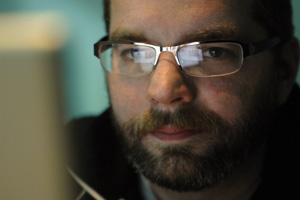 Jack Auses of NSIT Web Services Photo by Lloyd DeGrane | |
During the past several weeks, Senior Web Designers Stacey Shintani and Jack Auses have given tours of the new University Web site to groups of faculty, staff and students across campus. Celia Bergman, Associate Dean of Students for Health and Administrative Affairs, and Meghan Hammond, Project Analyst for Student Services, have assisted in recruiting and coordinating students to participate in the redesign process. Bergman, a member of the homepage committee, said her role throughout the project has been “to look at it through a student lens.
“Some of the feedback from me and Bill Michel (Assistant Vice President for Student Life and Associate Dean of the College) focused on the organization of information on the student page,” said Bergman, “specifically, topics listed under Student Life and Resources. There were a couple of sites we thought should be included that directly address resources for graduate and professional students, such as the Graduate and Professional Student Gateway and the Office of Graduate Affairs.
“We also discouraged the use of acronyms to identify any offices on campus that serve the needs of students,” added Bergman.
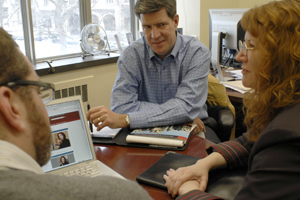 Jack Auses (left), co-design lead on the Web redesign project, and John Mohr, Director of NSIT Web Services, meet with Vice President for Communications Julie Peterson to discuss preparations for the beta site launch for the University homepage. Photo by Beth Rooney | |
Graduate and undergraduate students have joined in the exchange of ideas and maintained a flow of feedback throughout the project. They may not get everything on their Web wish lists, such as direct links to student-generated blogs, press articles and videos. But some students, including Scott Duncombe, Student Government President and fourth-year in Chemistry, are impressed with the direction in which the University has taken the homepage.
Duncombe, who participated in the guided tour, said, “It’s very refreshing to look at a page and see new content that’s being grabbed from all over the University—because content’s being generated all over—and to see it there right away.”
As president, Duncombe advocates for undergraduate students. “I know they’re not trying to build a student hub or portal, but it would be great to have students be able to put content on the site real easily. The student page is a natural route for people coming here to get to the Maroon, to get to the students’ pages. Adding some content stream or diversifying it could integrate it all into this new site. I think visiting students would like to see that content,” he added.
Jeff Hammond, a graduate student in Chemistry who has been providing feedback, said he likes the site’s overall flexibility, especially because the design allows a wide variety of new content to be integrated easily, unlike the current page. Hammond’s initial concerns addressed the needs of a group that might not view the site as Web designers, such as the parents of students and those who speak English as a second language. But, he specifically advocated for people with impaired vision.
“There are a couple of reasons for that. One, I come from a long line of people who are totally near-sighted, so having a Web page you can zoom in and out on is real important. My best friend in the department is legally blind. So, I’m thinking, ‘How do we use this when our eyes aren’t doing too well?’”
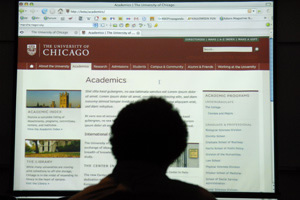 Much, but not all, of the content available on the current homepage and the secondary linked pages remains a part of the new Web site structure, and it has been retooled so users can navigate with ease and speed. “We have been careful not to overload the site,” said Stacey Shintani, Senior Web Designer in NSIT Web Services, who co-led the redesign project. “There’s a lot of information here, but it’s well organized.” At the top of the homepage, basic information resides in the utility navigation tool, such as the A-Z Index, Maps, Make a Gift and the search function. Directly below is the main navigation tool, which directs visitors to the secondary pages About the University, Academics (shown above), Research, Admissions, Students, Campus and Community, Alumni and Friends, and Working at the University. Five main feature stories drive the page’s visual impact, with smaller timely and weekly features positioned as secondary elements. A news module, which will be updated regularly, also lives on the main page, as do spotlighted University initiatives, priorities and resources, ranging from Arts at Chicago to Odyssey Scholarships and Mind Online research videos. Lectures, concerts, art exhibitions and major events on campus also will be represented. | |
As far as ease of use vs. visual elegance, Hammond leans toward the practical, user-friendly camp. “I’m trying to advocate on behalf of those who don’t care if it looks ugly,” as long as the site is readable for everyone using it, he said.
But the design of the new Web site is anything but ugly, said Duncombe and Hammond. Shintani noted it is “universally beloved, so far.”
“The homepage redesign is fantastic,” said Nagdeman. “The Web Services team has done an amazing job managing the process. I feel they’ve represented the needs of the audience and University community very appropriately. We now have an opportunity to feature stories for alumni and friends in a more visually appealing way, and as we rebuild those sites, we know we’ll be well connected to the work already accomplished,” added Nagdeman.
“It’s definitely really professional looking,” said Duncombe, who also likes the new storytelling opportunities that highlight the human element of the University’s work.
Hammond likes the homepage’s new look and its greater ease of use. “I think it looks cool, I think it looks a hundred times better than the last one, but where it really succeeds is in terms of having a whole lot more content that’s one click away. With the old site, I basically bookmarked every page I ever used. It used to take me half an hour to find stuff,” said Hammond.
“There’s a combination of what does the University idealize itself as, and what are Internet users imagining?” said Hammond. “There’s sort of a balance between that, and the navigation is natural.”
Hammond came to Chicago from the University of Washington, where, he said, thinking forward about technology is part of the culture. A recent visit to his alma mater’s homepage gave him a new perspective. “Now I think U of C is the better homepage. It’s better than Harvard’s. It’s better than Cal Tech’s,” adding that a lot of university homepages are using a dated aesthetic that incorporates too much content.
“Aesthetics are more important to students than they are to the grandparents of students,” said Hammond, adding that most students expect Web pages to have the visual appeal of sites such as Facebook. He said the University’s new homepage “has an aesthetic that is competitive with that, and thus is going to keep students interested.”
Hammond and Duncombe point to the beta site homepage, where the lead story, titled “An Economic Case for Early Education,” resides with a large photograph of James Heckman, the Henry Schultz Distinguished Service Professor in Economics and the College, reading to young children.
“Seeing a Nobel laureate with 7-year-olds is a good step. This steps back toward the mainstream without compromising. It’s still emphasizing what the University is but doing it in a way that doesn’t make us seem removed from normative culture, which is part of our reputation,” said Hammond.
Both Hammond and Duncombe understand that a student portal is a separate project on NSIT’s list of future projects. “When you do something this transformational to develop the digital face of the University,” said Hammond, “you need to have a lot of higher-ups saying, ‘OK, this is what we endorse as being the new image.’ Once that happens, once this type of display has been approved, then other possibilities such as a student portal will trickle down. Starting with this is a good idea.”
![[Chronicle]](/images/sidebar_header_oct06.gif)
